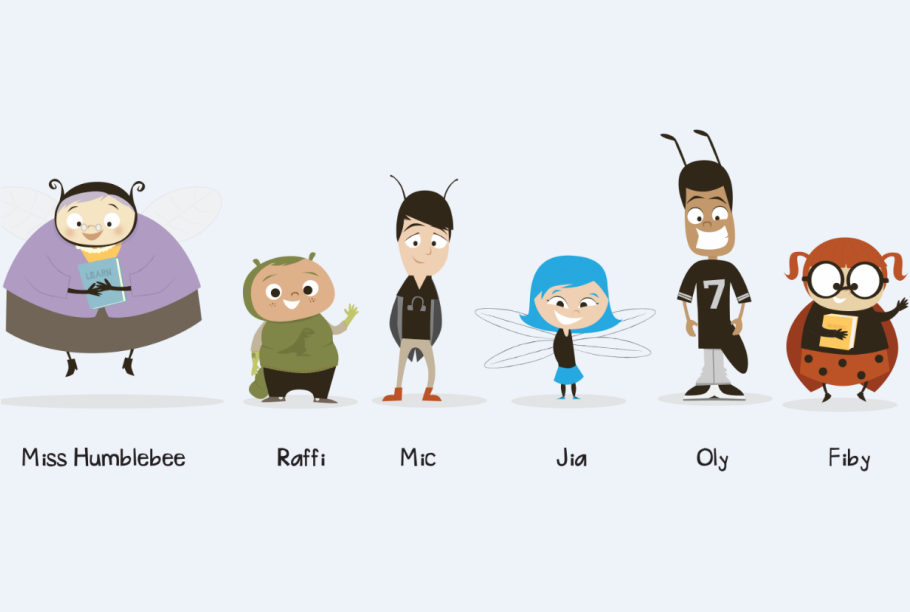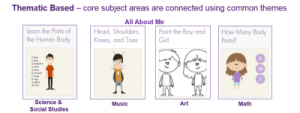By Tina Creguer
In 1954, a book publisher challenged Theodor Geisel (Dr. Seuss) to write a book using 250 words identified as key words for young readers to learn and instructed him to “bring back a book children can’t put down.” And indeed he did. His success in marrying learning, reinforcement, engagement, and fun in the seminal Cat in the Hat was unprecedented. His revolutionary approach introduced children to a way of learning that brought together appealing, relatable characters with basic learning concepts.
And so it is with Miss Humblebee’s Academy, a new, interactive online early literacy program that brings fun to learning for children ages 3 to 6 and supports their early academic development. This educational program features appealing cartoon characters that introduce key concepts in math, science and social studies, language and literacy, art, and music. And, as a bonus, it provides parents with tools to measure their child’s progress. The program, now available from Gale, is library based, but is accessible anytime, anywhere (even on mobile devices) so that families can choose the time and place to engage in learning activities.
Meet the creator
Crystal L abbe, founder/CEO/president of Miss Humblebee’s Academy, hailed “from very humble beginnings” and developed an early passion for helping children find their voice. Coming from a home where neither parent graduated from high school, she gained a love of learning from the Head Start program she attended, which she credits for shaping her lifelong interest in helping children attain early success in learning. Armed with a bachelor’s degree in communications and media relations and a master’s degree in elementary education (Long Island University, 2005), she started her career in education, writing curriculum for children.
abbe, founder/CEO/president of Miss Humblebee’s Academy, hailed “from very humble beginnings” and developed an early passion for helping children find their voice. Coming from a home where neither parent graduated from high school, she gained a love of learning from the Head Start program she attended, which she credits for shaping her lifelong interest in helping children attain early success in learning. Armed with a bachelor’s degree in communications and media relations and a master’s degree in elementary education (Long Island University, 2005), she started her career in education, writing curriculum for children.
She also taught in the classroom, working with kids on early literacy skills. Of that experience, Labbe says, “I learned that if you can help children as much as possible before they enter school, then when they go to school it can be an exciting and welcoming time in their life instead of a time of fear.” Her assignment of teaching English to children in Italy increased her understanding of the challenges of acquiring language skills.
Passion + Knowledge = Miss Humblebee
While Labbe tinkered with various versions of a learning program in graduate school and beyond, the characters (a charming group of insects with big personalities) and final elements began to solidify several years ago. The culmination of her own early learning experiences, passion for helping children become excited about learning, and academic training in communications and teaching resulted in Miss Humblebee’s Academy. The insects, she says, became the focal characters due to her son’s fascination with bugs at a critical time in the program’s development. And the name “Humblebee”? Labbe credits that to the interest she and her husband have in remaining “humble in their hearts” and in helping children to understand the value of that quality.
Labbe believes that a key element to successful learning is confidence. And to engender confidence, Miss Humblebee’s Academy incorporates progress reports that are kid friendly. “Kids can see that they are achieving and completing lessons. They achieve rewards and earn the right to go into ‘reward rooms,’ which provides ongoing incentive and encouragement,” says Labbe.
Curriculum, not games
A key difference between Miss Humblebee’s Academy and other learning programs is its approach, says Labbe. “We are not a game-based program; we are curriculum based.” The program is not intended to replace an entertainment activity. Rather, it is a learning activity that incorporates fun and engagement and brings inherent satisfaction through accomplishment. In addition, the program is interdisciplinary by nature. Rather than focus on one specific subject area, Miss Humblebee’s Academy integrates learning across multiple subject areas and gives children greater fluidity among subjects as they learn.
Other differences abound, too. Labbe explains: “The curriculum is adaptive, so kids are challenged. We do an assessment of each child at the beginning so we can track the growth and development as they go through the program. Parents receive weekly email notifications to view the progress report so they have awareness of what is happening with their child’s development. Our assessment is based on existing cognitive tests, such as and the Otis-Lennon School Ability Test and Wechsler Preschool and Primary Scale of Intelligence, to determine kindergarten readiness.
“Miss Humblebee’s Academy leads student through concepts, ensuring that they move from point A to point B, and hit all of the points along the way. We introduce children to concepts that they may not otherwise see until kindergarten. It gives the children – regardless of their home environment — confidence to succeed when they get to school,” she says.
“I wanted to provide pre-k kids with a program that would encourage learning and give them a level playing field from the beginning, regardless of their exposure to learning at home. I want them to have the confidence to raise their hand when they aren’t sure of the answer. I want kids to believe that they have a voice, and they should be proud to share what they have to say or what they created.”
–Crystal Labbe, creator, Miss Humblebee’s Academy
Early learning begins now
Libraries can bring Miss Humblebee’s Academy to young learners in their community, starting today by requesting a free trial. And for more information about how Miss Humblebee helps children learn, visit www.gale.com/mha.
[alert-info]
 About the Author
About the Author
Tina has been a library fan-girl since childhood, when she visited weekly with her family. She can be found many mornings standing outside her hometown library at opening time, waiting to nab a study room.
[/alert-info]2020 Air Jordan 1 Retro High OG Sail Obsidian University Blue 555088-140 – Buy Best Price Adidas&Nike Sport Sneakers



